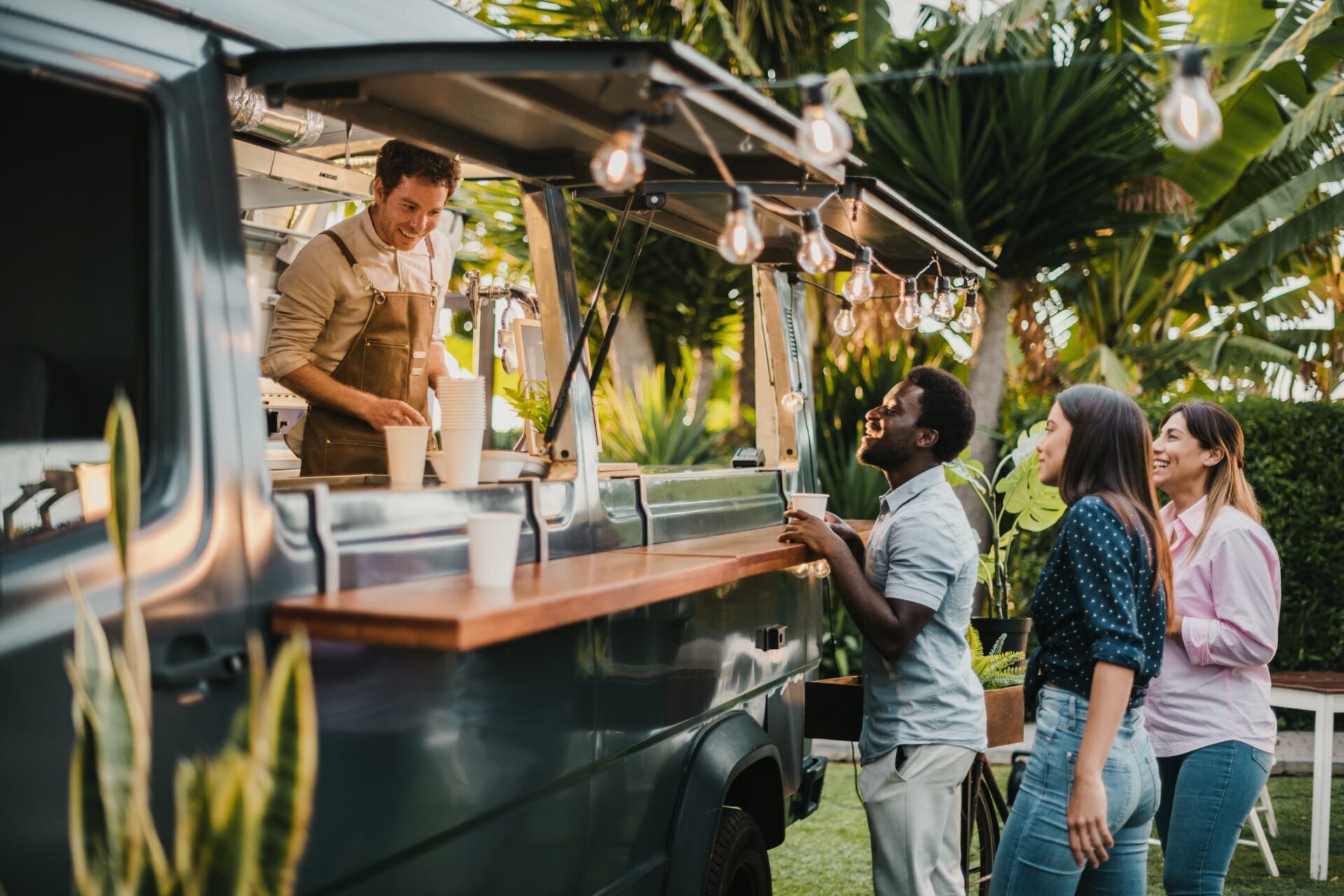Language:
How to Start a Food Truck Business

Many people with culinary skills or a passion for food dream about opening and running their own restaurant. But starting a brick-and-mortar restaurant has higher startup costs than most people can muster.
There’s an alternative for those aspiring chefs out there, and that’s the booming food truck market. Food trucks allow for a lower barrier to entry into the restaurant world, which makes it easier for people to get their foot in the door.
Also, many successful food trucks can then expand their brand to either more food truck locations or even a full restaurant.
If this sounds like something you would like to pursue, we have all the steps necessary to get a food truck started in the rest of the article below.
Scope Out the Market
Market research is vital to any business startup. You need to fully understand the market and customer behavior where you plan on doing business.
With a food truck, this likely means your local area or neighborhood. You’ll want to investigate other food trucks in the area to see what they’re selling and what customers want.
Most urban areas have specific lots for food trucks to gather, so this research should be relatively easy to conduct.
Come Up With a Unique Food Truck Concept
As with any business, you need a way that helps your brand stand out from the rest. This could be because you offer a type of food nobody else is offering.
You could also offer similar food to other food trucks but use higher quality ingredients, have better culinary skills, etc.
Either of these strategies can give you an edge if you are able to successfully pull them off. What you want to avoid though is blatantly copying another successful food truck without adding your own angle that improves upon it.
So decide what is going to make your food truck different and make that a guiding principle throughout the rest of your development.
Secure the Right Equipment
Food trucks require a lot of specialized equipment in order to operate. Some of this is similar to traditional restaurant equipment but fitted for use in a food truck.
Also, depending on the type of food you are preparing, you may need different equipment. For example, a food truck that specializes in pastry items will need different equipment than one that specializes in grilled meats.
Research other food trucks that are offering a similar menu to what you plan on offering. Then use those as a basis to decide what equipment you may need.
Feel free to customize this based on your own workflow and cooking style. If you’re a chef with a unique take on food, you will likely have a different style than other chefs. So make sure to customize your truck for your own way of preparing dishes
Finance Your Food Truck Business and Equipment
Although a food truck is generally less expensive than opening a restaurant, it still does cost money to get all the equipment.
You have two options for this. One option is to lease the truck. Several services exist that can help with leasing a food truck. You’ll generally pay higher monthly costs when leasing.
Another option is through business loans or business credit. These can be through your local bank or credit union. Another option is the Small Business Administration. This government agency offers small business loans of up to $5 million for qualifying applicants.
You likely don’t need that much, but many SBA loans have very friendly terms, so it’s important to look into them. They do require extensive paperwork, more so than your typical bank loan, since they are guaranteed loans.
Design and Construct Your Food Truck
After you decide on a name, you’ll want to start working on branding for your business. This will include your food truck and is one of the most fun and creative aspects of starting one.
Decide on the look of your truck like the color scheme and other physical attributes that help set your truck apart from the rest. The look and colors should quickly communicate to customers what you offer and what makes you different.
This also includes menu signage around your truck. Never miss an opportunity to further your brand image.
Solidify Your Menu
You probably already know what type of food you want to serve, but you need to decide exactly how you are going to sell each item.
This includes things like specific entrees, side orders, combinations and even sizes for each item.
A lot of this will be based on what other similar restaurants are offering, but you will also want to consider your own situation. For example, carrying too many side orders or sizes may be too difficult to manage from a truck.
Try to have a varied menu that satisfies customers but also a menu you can handle and work with during busy times. Remember, your menu may also be an evolving aspect of your business that you tweak as you notice trends in sales and receive customer feedback.
Source Your Food and Supplies
Most areas will have restaurant supply companies that serve many of your area’s local restaurants and food industries. A search should turn up several of these for you to look into. These can be used for general-purpose items, such as food cartons, cups, napkins, etc.
They may also offer branding on these items if you order enough quantity.
For specialty products and ingredients, you may have to dig a little deeper. Food truck owners are a pretty tight-knit community, so you may be able to ask other local owners about specific ways they source their ingredients.
Some food truck owners also use local farmer’s markets and other local suppliers to give their food a unique identity and local flavor. So this may be another option to source ingredients.
If you go this route, make sure to let your customers know your food is locally grown or farmed. It’s a great way to help differentiate your food truck from the competition.
Establish Your Pricing Model
This area may be one of the more difficult tasks, especially if you’re more into cooking than business-related topics.
But this is a crucial step to making sure your business is successful. It’s not uncommon for new restaurants to be busy all day but at the end of the month, the owner is unable to pay the bills simply because the money coming in was not enough to cover costs.
To start, properly determining your menu prices will take a little bit of forecasting until you have concrete sales numbers to use as a guide instead.
For the next step, you’ll want to figure out your monthly costs. These are generally fixed for the most part. They include monthly payments on loans, rent or storage fees and other recurring costs. In business terms, these are known as operating costs, meaning they are operational expenses but not directly related to producing the product being sold.
This monthly amount plus the actual raw materials or ingredients for the food sold will be your break-even point each month that you will use as a baseline.
Next, add up your cost for supplies and ingredients. You can break this up into shorter periods of time. For example, how much will you need to buy to fulfill a day or a week of typical orders?
Then, estimate how many orders of each item you can produce with the supplies you purchased. Divide the total cost for the supplies by the number of servings it can fulfill, and it will give you the cost per item.
For example, let’s say you sell burritos. Let’s also assume that for $500 you can buy enough ingredients to produce 100 burritos. In this example, your cost to produce each burrito is $5 (100 x $5 = $500).
Anything above this amount is profit. But remember, you will still need to deduct your operating costs mentioned above from this total at the end of the month. This will reveal what is known as your operating profit.
For reference, you will also want to compare prices to similar food trucks in your area. You’ll likely want to be priced similarly to them unless there is a specific reason your product should cost substantially more.
That may be possible, and many businesses succeed by offering higher quality items at higher prices. But make sure to determine if that’s your business model or not.
Make sure to take your time when determining menu prices. Opening a business with one set of prices and then quickly raising them can upset customers and hurt repeat business.
Research Local Regulations and Requirements for Food Trucks
Many cities both large and small now have food trucks, so there are laws and regulations that must be followed. This will also include where you can do business.
Most cities will have specified areas where food trucks can operate, so you’ll need to abide by these laws. This will likely determine the location of your food truck. You’ll likely also need a business license to operate in the city.
Next up are regulations regarding health, safety and waste disposal. These will differ by area, but you’ll need to be aware of these and follow all regulations to avoid fines or even the loss of your business.
Your local country or state government health department is usually the agency that oversees these regulations. So contact your local health department for information on regulations in your area.
Develop a Strong Marketing Plan
Marketing is key to any business, and a food truck is no different. You’ll need a good plan that both reaches the right potential customers and one that also fits your budget.
A lot of marketing these days can be done for free. Social media profiles are a great way to get your message out there for customers to see.
Also, if there are any local food-related social media accounts in your area, try to reach out and make contact with them to see if they can mention or help promote the launch of your new food truck.
Next, traditional marketing such as print advertising, direct mail and online ads are also available. These often require specific experience to get the most return on your budget though. Because of this, avoid spending a large amount of your marketing budget on advertising unless you know exactly what you’re doing or have hired an expert to help you.
Launch Your Food Truck Business
All your hard work has finally paid off and the day has come to officially launch your food truck business.
It’s a very exciting time and one you should be proud of. But the work doesn’t stop here. Every good entrepreneur knows that being able to adapt is the key to success.
So once you launch, keep a close eye on expenses, prices and customer feedback. Look for areas where your forecasts may have been wrong and make adjustments to fix the problem before you run into possible financial difficulties.
Remember, as the owner you have to stay ahead of problems to make sure they never threaten your business.
Don’t Forget to Establish Your Food Truck Business Entity
Of course, no business is official until they register as a legal entity in their state. This can be as a partnership, an LLC or even a corporation. But none of the steps we outlined above can begin without legally registering your business first.
This is where doola can help. We have all the tools to get your business registered fast in all 50 states so you can get your food truck up and running as soon as possible.
Get Your Food Truck Rolling with Help from doola
When launching a food truck business, you have a lot on your plate. The last thing you need is to worry about more paperwork.
When you’re ready to start on your food truck journey, let doola handle your business registration. We make it fast and easy to register your business as an LLC or other entity in your state.
Remember, many of the steps outlined above require you to already be registered as a business entity. So contact doola today to start your new dream business as a food truck owner.
FAQs
What are the startup expenses for a food truck?
The main startup expenses for a food truck are the truck and the equipment. Supplies and inventory are the second largest expenses. Finally, there are costs for liability insurance, rental fees and permits. These costs can range anywhere between $40k and $100K or monthly payments of $2,000 to $3,000.
Are food trucks a good business?
Yes. A food truck can be a great business. However, it does require hard work, research and dedication, the same as any other business.
How profitable are food trucks?
Every situation is different, but food trucks can bring in anywhere from $20k to $50K per month in revenue according to Profitable Venture.




